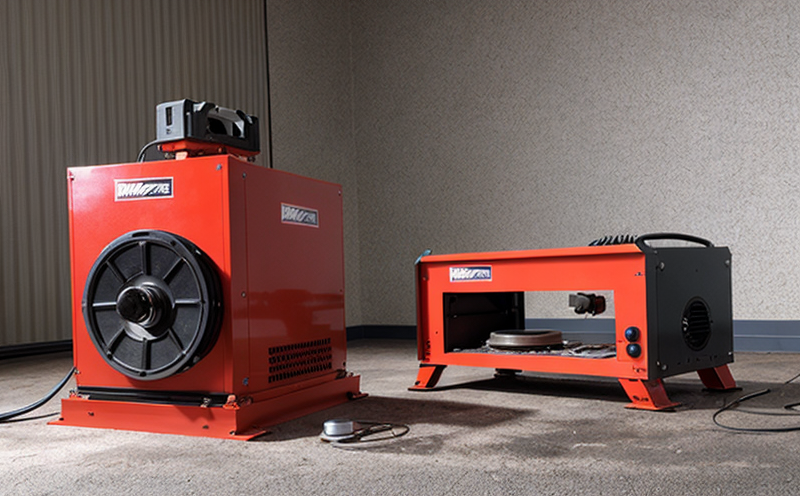ASTM D999 Vibration Testing of Shipping Containers Validation Method Development Test
The ASTM D999 vibration testing method is a critical validation process used to ensure that shipping containers meet the rigorous standards set forth by the American Society for Testing and Materials (ASTM). This test focuses on assessing the durability and integrity of containers under simulated transportation conditions. For quality managers, compliance officers, R&D engineers, and procurement specialists involved in logistics or manufacturing, ASTM D999 is a cornerstone of ensuring that shipping containers can withstand the harsh realities of global transport.
The testing process involves subjecting the container to controlled vibration frequencies and amplitudes that mimic real-world conditions. The goal is not only to identify potential weaknesses but also to refine the design for better performance. This method helps manufacturers improve their products by providing empirical data on how containers behave under stress, thus enhancing overall product quality.
The ASTM D999 test ensures compliance with international standards and industry best practices. It allows companies to validate that their shipping containers meet safety requirements, ensuring the safe transportation of goods across borders. This process is particularly vital in sectors like maritime transport, automotive logistics, and electronics manufacturing where the integrity of packaging is paramount.
Developing a robust validation method involves several key steps: defining the test parameters, preparing the specimen (the shipping container), selecting appropriate instrumentation, conducting the test, and interpreting results. Each step must be meticulously executed to ensure accurate and reliable outcomes. The testing apparatus typically includes shakers capable of generating specific frequency ranges and amplitudes.
Specimen preparation is critical; this involves ensuring that the container is in its standard configuration with all necessary fittings intact but not overloaded beyond the expected weight. Calibration of the test equipment is another crucial aspect to maintain precision throughout the testing process. Once prepared, the container undergoes vibration tests that simulate various transport modes such as road, rail, and sea.
The ASTM D999 method employs a multi-step approach to assess the durability and integrity of containers. After each phase of the test, detailed observations are made about any deformations or failures observed in the container. These findings provide valuable insights into areas needing improvement. The results generated from these tests serve as evidence supporting claims regarding the robustness of shipping containers.
Developing a reliable validation method requires collaboration between various stakeholders including manufacturers, logistics providers, and regulatory bodies. By leveraging this collaborative approach, we can enhance our understanding of how best to protect valuable cargo during transit. Such efforts contribute significantly towards improving supply chain efficiency while ensuring safety standards are met consistently worldwide.
Scope and Methodology
The ASTM D999 vibration testing method encompasses a comprehensive set of procedures designed specifically for validating the structural integrity of shipping containers used in various industries. The scope primarily covers the evaluation process which includes defining test parameters, preparing the specimen (shipping container), selecting appropriate instrumentation, conducting the tests according to specified conditions, and interpreting results.
The methodology begins with establishing clear objectives aligned with industry standards such as ISO or ASTM guidelines. This ensures that all parties involved understand what needs to be achieved during testing. Specimen preparation involves ensuring that the container is in its standard configuration without any additional load beyond expected weights. Calibration of the test equipment follows this step to maintain accuracy throughout the testing process.
Conducting the actual tests requires precise control over environmental factors like temperature, humidity, and vibration frequency/amplitude. Various types of shakers are utilized depending on the type of transport being simulated – road, rail, or sea. Observations made during each phase help identify any deformations or failures within the container structure.
Interpreting results involves analyzing data collected from various sensors placed strategically around the container to capture key performance indicators (KPIs). These KPIs could include structural deformation levels, internal pressure changes, and overall stability metrics. Based on these analyses, adjustments can be made to improve future designs or manufacturing processes.
Industry Applications
| Industry Sector | Description of Application |
|---|---|
| Maritime Transport | Vibration testing ensures that containers can withstand harsh ocean conditions, protecting goods from damage. |
| Automotive Logistics | Evaluates the robustness of components inside shipping containers to prevent deformation during transit. |
| Electronics Manufacturing | Tests the ability of packaging materials to protect sensitive electronics against mechanical shocks. |
| Aerospace Supply Chain | Validates container integrity for transporting critical parts and components securely across long distances. |
| Pharmaceutical Distribution | Safeguards fragile medications by ensuring containers can maintain their structural stability during shipment. |
| Retail Supply Chain | Ensures that consumer goods are protected throughout distribution networks, reducing instances of product damage. |
| Construction Equipment Manufacturing | Guarantees that heavy machinery components remain undamaged during shipment to remote locations. |
| Beverage Industry | Protects delicate beverages from mechanical stress that could affect taste and quality. |
The ASTM D999 method is widely recognized across multiple industries for its ability to provide robust validation of shipping containers. By simulating real-world transport conditions, this testing ensures that goods are safely transported without compromising on quality or integrity.
International Acceptance and Recognition
The ASTM D999 vibration testing method enjoys widespread acceptance among international standards bodies and regulatory authorities worldwide. Its rigorous protocols have been adopted by organizations such as ISO, IEC, and EN to ensure consistent quality control measures across different regions.
Many countries rely on ASTM D999 when implementing national regulations related to packaging safety and durability. This includes the United States, European Union members, China, India, Japan, South Korea, Australia, New Zealand, Canada, Brazil, Mexico, Russia, Turkey, Saudi Arabia, Israel, and numerous other nations.
Adhering to ASTM D999 demonstrates a commitment to maintaining high safety standards and regulatory compliance. Companies that adopt this testing method can enhance their reputation for reliability and trustworthiness in the global market. It also facilitates smoother international trade by ensuring compatibility with diverse regulatory frameworks.





